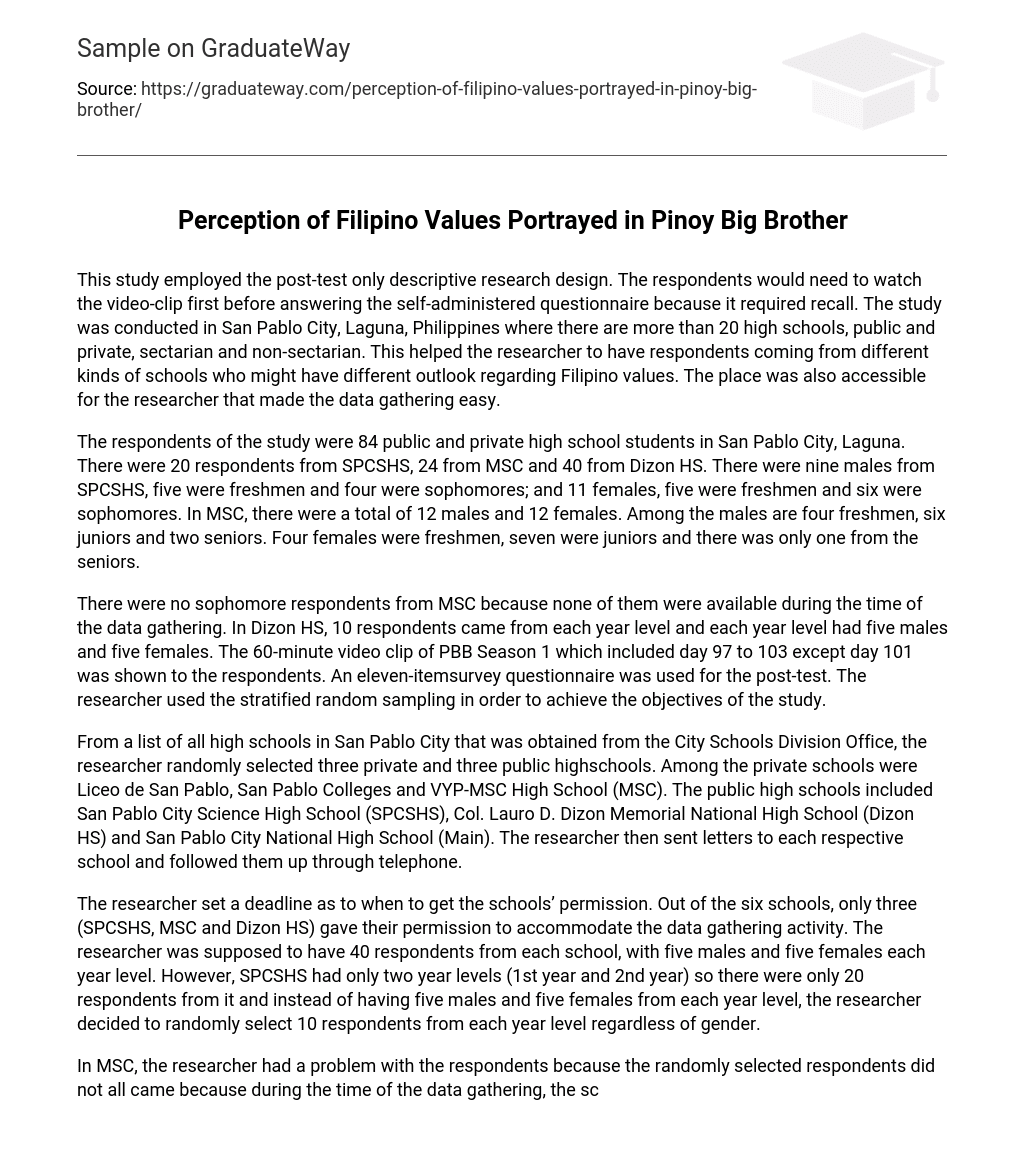This study employed the post-test only descriptive research design. The respondents would need to watch the video-clip first before answering the self-administered questionnaire because it required recall. The study was conducted in San Pablo City, Laguna, Philippines where there are more than 20 high schools, public and private, sectarian and non-sectarian. This helped the researcher to have respondents coming from different kinds of schools who might have different outlook regarding Filipino values. The place was also accessible for the researcher that made the data gathering easy.
The respondents of the study were 84 public and private high school students in San Pablo City, Laguna. There were 20 respondents from SPCSHS, 24 from MSC and 40 from Dizon HS. There were nine males from SPCSHS, five were freshmen and four were sophomores; and 11 females, five were freshmen and six were sophomores. In MSC, there were a total of 12 males and 12 females. Among the males are four freshmen, six juniors and two seniors. Four females were freshmen, seven were juniors and there was only one from the seniors.
There were no sophomore respondents from MSC because none of them were available during the time of the data gathering. In Dizon HS, 10 respondents came from each year level and each year level had five males and five females. The 60-minute video clip of PBB Season 1 which included day 97 to 103 except day 101 was shown to the respondents. An eleven-itemsurvey questionnaire was used for the post-test. The researcher used the stratified random sampling in order to achieve the objectives of the study.
From a list of all high schools in San Pablo City that was obtained from the City Schools Division Office, the researcher randomly selected three private and three public highschools. Among the private schools were Liceo de San Pablo, San Pablo Colleges and VYP-MSC High School (MSC). The public high schools included San Pablo City Science High School (SPCSHS), Col. Lauro D. Dizon Memorial National High School (Dizon HS) and San Pablo City National High School (Main). The researcher then sent letters to each respective school and followed them up through telephone.
The researcher set a deadline as to when to get the schools’ permission. Out of the six schools, only three (SPCSHS, MSC and Dizon HS) gave their permission to accommodate the data gathering activity. The researcher was supposed to have 40 respondents from each school, with five males and five females each year level. However, SPCSHS had only two year levels (1st year and 2nd year) so there were only 20 respondents from it and instead of having five males and five females from each year level, the researcher decided to randomly select 10 respondents from each year level regardless of gender.
In MSC, the researcher had a problem with the respondents because the randomly selected respondents did not all came because during the time of the data gathering, the school had an activity and so not all the selected respondents were available. Instead, the researcher gathered the remaining selected respondents and allowed some other students who were willing to participate in the study. Only Dizon HS was able to provide the preferred number and classifications of the respondents (five males and five females from each year level). The data were analyzed using descriptive statistics which basically included frequency counts and percentages.
III. Conclusion More than one-third (34. 75%) of the respondents who were exposed in PBB cited that they watched the show because lessons could be learned from it and that it was good and fun to watch. These two reasons were the same reasons for all the schools, per year level and per gender. This implies that high school students wanted to watch shows where they could have fun while learning. All the respondents perceived Filipino values in PBB. This implies that PBB shows Filipino values. However, this does not show yet whether or not they perceived positive Filipino values.





